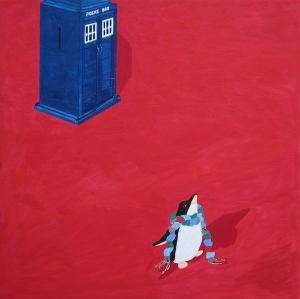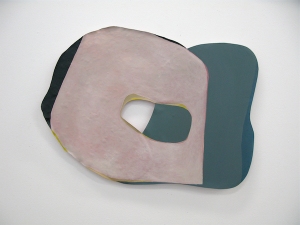Intimate Worlds
5 December – 20 December
Fleur MacDonald, Stephanie Monteith, Anie Nheu, Catherine Rogers and Kaye Shumack
Catherine Rogers, Sea In Paint Red Sky Green Sea. Photograph. Image credit: Catherine Rogers
Read Glenn Locklee’s review on sixtoeight
Artist Profiles
Fleur MacDonald

Giorgio Pengee failed his audition to be the next Dr Who and has decided to set his sights on Starfleet instead, 2014. Gouache on wood panel, 40 x 40cm.

Fratingi the grey knitted Bunny from Kandos and the jilted lover of Giorgio Pengee can’t decide whether to fall in love with the Dalek or fight it with a broken pencil, 2014. Gouache on wood panel, 40 x 40cm.
Fleur MacDonald has been exhibiting since 1985, staging thirteen solo’s and over 60 group shows. Fleur is mainly a still life painter but dabbles in landscape photography. She has been a finalist in the Gallipoli and Mosman Art Prizes, and her work has featured in commercial and private collections all over the world.
This series represents fragments of my life, the Penguin’s failed quest to become the next Dr Who, a collection of badges I have worn through life and a small section from my vast pencil collection.
Stephanie Monteith

Black Slipper, 2014. Oil on board, 25 x 30cm

Hibiscus, 2014. Oil on board, 25 x 30cm

Flannel Flower, 2014. Oil on board, 25 x 30cm

Butterfly Orchid, 2014. Oil on board, 25 x 20cm

Nasturtium, 2014. Oil on board, 25 x 20cm

Evening Primrose, 2014. Oil on board, 25 x 20cm
Stephanie Monteith is a Sydney based painter who has developed diverse modes of paint application aimed at conjuring recognisable, but often unlikely scenarios.
The paintings exhibited in Intimate Worlds are studies for a large scale work dealing with the nature of perception. Each of these small studies speaks of an intimate engagement with the subject – both through the time spent studying and painting each flower, as well as actually growing and nurturing the plants.
Anie Nheu

The Handstand (left), 2014. Acrylic, oil on marine ply, 224 x 39 x 52cm

Ingested, 2014. Acrylic, oil on impasto and polyester, 50 x 70cm

The Temptation To Hover, 2014. Oil on plywood, 40 x 69cm

Impasse#2, With Twisted Logic, 2014. Oil on canvas. 34 x 33.5cm

Impasse#4, The Stand, 2014. Acrylic, oil on marine ply, 52 x 43cm
Anie’s practice focuses mainly on drawing, collage and painting. Her interest in the body and its sensory processes to make sense of our experiences has sustained her studio work. She has exhibited in Sydney, Korea and Beijing and has been a finalist in some art prizes. This year she was a finalist in the Mornington Peninsula National Works on Paper and Fisher Ghost Art Award.
The premise for this exhibition is to make a group of 4 to 5 paintings and explore their connections to one another with an underlying theme of Intimate Worlds.
In exploring this theme, it came to mind that perhaps it’s a prerequisite to have an ‘outer’ and ‘inner’ world to arrive at an intimate world. Each painting was individually conceived with its own characteristics and feel. They were then further resolved as a whole after juxtaposing and assigning them their place in the group. As the work developed, I was taken by the emotional narrative that emerged through the play of visual texture of the paint and the dynamic interactions of the shapes of the paintings through both: from within, and from the shapes these paintings. Towards the end, I thought the group was telling me the title of its configuration: we watched as she did her handstand single handedly.
Catherine Rogers

Red Sky, Green Sea. Ink Jet Print.

Sea In Paint, Big Blue. Ink Jet Print.

Sea In Paint, Big Sky. Ink Jet Print.
Catherine Rogers has produced a series of 12 works over a sustained period of time visiting art museums and photographing details of both well known and lesser known paintings. Looking at Painting – Paintings of the Sea reveals an extraordinary amount of detail that may otherwise be overlooked whether it be a hair embedded in the texture of the paint, an exquisite collision of colour or the reflection of gallery lights on the glass under which the work is protected.
All works are produced in an edition of 5, plus two artist’s proofs. 76 x 56 cm, Ink Jet prints.
Kaye Shumack

Orange chair in the sun, 2014. Acrylic on paper, 45 x 60cm (framed). Photo credit: Kaye Shumack

Where the lemon trees go in winter, 2014. Acrylic on paper, 67 x 54cm (framed). Photo credit: Kaye Shumack

Field of feelings, 2014. Oil on paper, 67 x 53cm (framed). Photo credit: Kaye Shumack
Kaye Shumack is a Sydney-based visual artist, who has recently returned to exhibit paintings. Kaye is an academic and researcher in visual and social design systems, communications and practices. Kaye’s research work explores the ways in which social interactions in public and common spaces can be used to reveal new insights about possible futures. Recent projects include explorations of human movement through mappings of place and memory.
The paintings in this exhibition were developed at a recent workshop in Tuscany, Italy. These works focus on the depiction of an intimate connection with a particular place and time, as moments of intensity; as liminal states of connection with the material world. Such openings speak to the importance of textures, colours, shapes and flows, objects and signs, in the shaping of our internal worlds.


0 Comments